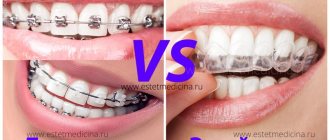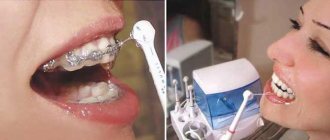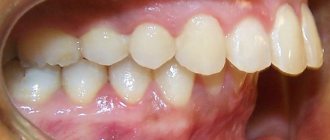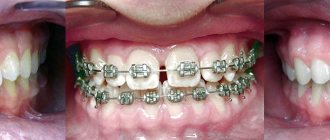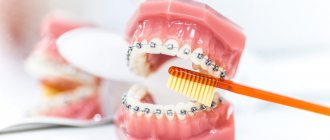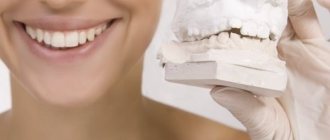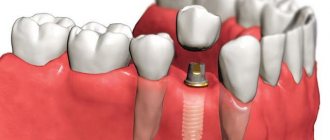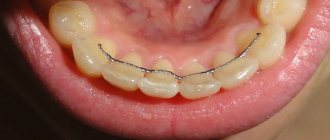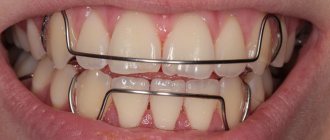Mouthguard for athletes made of silicone
Such mouthguards are used to protect teeth in contact or extreme sports - football, hockey, boxing. Sports mouthguards are worn over the front teeth and reduce the strong physical impact not only on the teeth, but also on soft tissues and even the cervical spine.
Based on manufacturing methods, there are two types of sports mouthguards:
1. Standard sports mouth guard
Sold in any sports stores, made the same for everyone.
2. Individual sports mouth guard.
It is made individually for a specific person using impressions of his teeth, taking into account their anatomical shape. They cost much more, but are also much more convenient, since they fit on the teeth “like family.”
Manufacturing
Mouthguards are made individually. They are a one-piece device made of many silicone caps. Each of them tightly grips an individual tooth and prevents it from moving.
The manufacturing process takes place in several stages :
- The orthodontist removes the braces and makes a model of the mouth guard using plaster casts. It is performed by a dental technician in a laboratory within a week.
- If necessary, the oral cavity is sanitized. They remove plaque, tartar, cure caries, gum inflammation, and cover the units with remineralizing and fluoride-containing gel.
- Perform fitting and fitting of the product. If it interferes, make adjustments - sand or cut off the protruding areas.
Mouthguards are made individually.
Additional Information! For children, you can paint the mouth guard any color. And if the treatment was carried out not with braces, but with aligners, then the last product from the set is used as a retention device.
Dental mouth guard
Unlike a sports mouthguard, which is used only for impact protection, a dental mouthguard has a wider range of applications. A dental mouth guard is made from special plastic materials – silicone or polyurethane.
The convenience of the mouth guard is that it can be used to solve many problems - from therapeutic to orthodontic treatment. And at the same time, the mouthguards are convenient to use - the patient can take them off and put them on himself, according to the schedule established by the attending physician.
Types of removable mouthguards
Dental mouthguards differ in material, duration of wear, and production technology:
- Standard models are made according to one sample and do not take into account the specifics of an individual bite. Therefore, they are rarely used after braces. These types of trays are often used for teeth whitening.
- Thermally modeled retainers. Their peculiarity is that they take the unique shape of teeth after heating. Such a mouth guard is first placed in hot water and only then put on the jaw.
- Individual models are the most accurate and convenient. They are made according to the individual anatomical parameters of a particular patient based on a cast of the jaw.
According to the period of wearing, mouthguards are available at night and around the clock. The first ones are worn exclusively at night and are used in “mild” cases of bite correction. They are worn around the clock, removed only during meals and before oral hygiene. These models are suitable for correcting severe malocclusions.
According to the material, mouthguards can be made of silicone and bioplastic. Both options are distinguished by good hypoallergenic properties, transparency and non-invasiveness.
Orthodontic dental guards
These aligners are used to correct malocclusions. At the moment, there are several types of orthodontic aligners on the market from different manufacturers, including Star Smile aligners, the well-known aligners.
But not all orthodontic aligners are capable of solving serious bite problems; they only help to close the spaces between the teeth and correct minor curvatures.
Much has changed when Russian-made orthodontic mouthguards or aligners from the Star Smile company appeared; they became serious competitors to braces, since they can correct almost all defects in the development of bite.
Wearing time
Only an orthodontist who deals with your case can clearly answer this question. It is he who, taking into account individual characteristics, develops a scheme for wearing mouthguards that will preserve the correct bite and reduce the patient’s inconvenience to nothing.
As a general rule, the course of wearing a mouth guard begins with two hours a day. After a month, the structure is worn for the whole night. This order is maintained for several months.
After the prescribed time, it is enough to use the mouthguards 3-4 times a week. After at least a year, dental veneers are worn once a week.
A detailed algorithm for using these dental structures can only be determined by a specialist involved in occlusion correction.
How long you need to wear removable mouth guards depends on:
- type and degree of malocclusion (the period of use of mouth guards increases in case of complex disorders);
- the age of the person (persons over 30 years of age need longer exposure, unlike children);
- the opinion of the treating specialist (many doctors advocate long-term use of mouth guards).
Often the time of wearing the structure is equal to the period of treatment with braces, multiplied by two. Many specialists involved in correcting malocclusion express the opinion that it is necessary to wear mouth guards for as long as possible (several years).
At first, mouth guards may cause discomfort and speech impediments, but there should be no pain. It is imperative to follow the orthodontist’s recommendations when wearing a mouth guard.
You should not remove the structure without good reason, this will lead to the fact that the dentition will begin to return to its previous position and all efforts aimed at correcting malocclusion will be in vain.
Children's mouth guards for proper teething
These are silicone overlays for teeth, which are also called, among others. retainers, trainers. They are called teething mouthguards because they are most often used during the period of change of baby teeth to molars in children aged six to ten years.
The main purpose of teething trays or teething guides is to correct the position of the jaws and align the position of the child’s incisors during the period of early mixed dentition. They are worn for several hours during the day and all night while sleeping. The treatment period is approximately one year; during treatment, it is necessary to periodically visit an orthodontist to monitor the changes occurring.
Also, during the period of mixed dentition, children's aligners are used - children's orthodontic aligners. Since 2020, such mouthguards have been produced by the Star Smile company.
Advantages of mouth guards over other retainers
Orthodontists and patients choose mouthguards for their many benefits:
- low price;
- comfort - the device does not rub the mucous membrane and does not cause discomfort; the teeth from the mouth guard can only hurt if the patient has not worn it for several days;
- hypoallergenic: the reaction is extremely rare - in 2-3% of patients;
- aesthetics - the mouthguard is almost invisible on the teeth, it can only glare in the sun or in photographs with a flash;
- easy care - even a child can maintain hygiene;
- the ability to remove the device for meals, brushing teeth, and public speaking.
The device does not need to be worn constantly.
Additional Information! However, retention aligners also have a drawback. During the adaptation period, diction disturbances are noted: it is especially difficult for the patient to pronounce hissing sounds.
Teeth whitening trays
There are at-home teeth whitening systems that also use dental trays. Whitening trays can be customized, standard, or disposable. Before using any whitening system, you should visit your dentist to determine what is right for you and will not harm your tooth enamel.
An individual mouthguard is made personally for the patient based on impressions of his teeth. For whitening, a special gel is used that is placed inside the tray.
Whitening at home usually takes longer than at the dentist's office because the gel used at home contains less hydrogen peroxide.
The whitening procedure should be carried out strictly according to the instructions provided. The gel is placed on the inside of the mouth guard, after which the mouth guard is put on and specially pressed to distribute the gel evenly. After putting it on, rinse your mouth with water and wear the mouthguard exactly as long as the instructions say. After removing the whitening tray, you should also rinse your mouth with water.
Role
Straight teeth, specially moved by braces, can eventually return to their previous incorrect position. The long journey of bite correction with the help of therapeutic structures is not the end of treatment.
After this stage, the dentist prescribes wearing mouth guards as a fixative therapy. The reason is that the human body by any means resists outside interference in the form of mechanical influence that is exerted on it from the outside.
Therefore, once teeth are freed from braces, they begin to acquire curvature again . To avoid such negative consequences, it is necessary to use dental mouth guards.
Such designs are carefully selected taking into account the individual characteristics of any patient. Each piece is made according to the size of a specific person.
Functions of a dental veneer after treatment with braces:
- Fixation of teeth in a new, correct position.
- Final alignment of the bite of patients of different ages.
- Protecting teeth from any external influences, for example, when chewing hard foods or playing dangerous sports.
In addition to mouth guards designed to be worn after braces, there are mouth guards for correcting malocclusion, as well as special devices for wearing while playing sports.
Applications on teeth using trays
These mouth guards are used to restore and strengthen tooth enamel. A special composition is placed inside the mouthguard, thanks to which the teeth are remineralized.
There are two types of mouth guards for dental applications – standard and thermoplastic.
Thermoplastic ones react to heat and soften when placed in hot water, and harden when put on the teeth.
Advantages and disadvantages of mouth guards for teeth straightening
To clearly evaluate all the pros and cons of aligners for correcting the position of teeth, we will compare the main factors in the following table:
| Advantages | Flaws |
| Predictability of the final result | High price |
| No discomfort, impaired diction, metallic taste, or injury to the oral mucosa when worn | Need to remove when eating |
| Aesthetic appeal (invisibility to others) | Inability to correct complex bite defects |
| Does not violate the integrity of tooth enamel | Lack of the desired effect if the orthodontist’s recommendations are not followed in good faith |
| There are no conditions for the proliferation of pathogenic microflora | |
| Simple hygienic care | |
| No need to give up any foods |
From the information given in the table, we can conclude that there are more advantages to treatment with aligners than disadvantages.
Mouthguards for night teeth grinding
Bruxism or nighttime teeth grinding is one of the serious diseases that affects approximately 3% of the world's population. The reasons for this have not been fully identified, but the consequences can be very serious - from abrasion of tooth enamel to deformation of the jaw joints. Wearing special mouth guards allows you to protect your teeth from premature wear, relieve muscle tension, and reduce headaches. For the effect to be effective, the mouth guards should be worn for up to 10 hours a day.
Mouthguards for the treatment of teeth grinding are distinguished by the time of their use. There are day guards that are worn during the day; they are transparent and almost invisible.
There are night guards that you wear while you sleep. They may differ in shape from daily mouth guards, but are also comfortable and imperceptible in the mouth.
What is a mouthguard and what is it for?
After the main orthodontic treatment, a retention period begins. It lasts 2–3 times longer than active correction. During this time, the patient must wear special structures - retainers.
One of these devices is a retention mouth guard, which is worn after braces are removed. This is a single jaw removable system. It is made of biopolymer silicone, completely transparent, and exactly repeats the patient’s dentition.
Retainers help secure the results of braces treatment.
A mouthguard is needed to prevent the bite from reoccurring. During orthodontic treatment, teeth move from their usual incorrect position to their natural – physiological one. The process is accompanied by changes in the structure of the jaw, vessels and ligaments that hold the units in the periodontal gap. Since it takes several years, maintenance therapy is necessary.
The device is placed on the teeth. The mouthguard must fit tightly so that the achieved result is maintained after treatment with braces. Wearing the system ensures complete formation of bone and soft tissue around the displaced units.
Retainer or mouthguard
After aligning the bite using braces or aligners, you must wear a special mouth guard or retainer that secures the result. In appearance, this tray looks like an aligner, only very, very smooth and even.
Retention aligners are made from special biopolymers; they are easy to use and almost invisible. These mouth guards are worn at night and worn for several hours during the day. The timing of wearing retainers is individual and depends on the degree of development of the malocclusion.
Wearing retaining trays after braces and aligners is mandatory, and this is the only way you can be sure that the teeth will not return to their original incorrect position.
WHAT IS A RETENTION CAP
Mouth guards (or aligners) for teeth are removable devices in the form of plastic overlays that fit onto the teeth. These clear braces are designed to hold teeth in a given position. They are made in such a way that they can be removed during oral care or the devices themselves. Mouthguards for teeth after braces are used in the following cases:
- at the time of teeth formation in childhood;
- for minor malocclusions;
- to avoid relapses after removing braces.
Aligners (or aligners) are made from special high-quality material that is harmless and does not cause allergic reactions. Thanks to the biopolymer material, the manufactured plates are transparent, light, and invisible.
The materials for the manufacture of these structures are hypoallergenic and do not harm the body in any way.
Also, mouthguards do not injure the mucous membranes of the oral cavity and do not cause noticeable discomfort.
Patients adapt very quickly to wearing mouth guards. This is due to their convenience, perfect fit and the ability to quickly remove. Mouthguards do not interfere with eating, talking, and can be easily removed and put on by their owner. Colored polymers are sometimes used for children. After all, it is more difficult for a child than for an adult to explain the need and importance of the retention period. To ensure that children enjoy wearing the necessary dental structures, they are often offered colored mouth guards. Such aligners are perceived by children as unusual decorations and often become the envy of their peers.
Mouthguards cannot be used instead of braces, as they can only correct minor malocclusions.
If mouthguards are prescribed to a patient as the main type of treatment, this means that he has minimal problems with the alignment of his teeth. In such cases, the aligners are changed several times, bringing the teeth closer and closer to their ideal.
Timely placement of aligners not only maintains a positive result, but also reduces the period of use of braces.
Luminous decorative burls
Here manufacturers have a wide range of options, as they say - for every taste and color. And even light, which, thanks to technology, is now built into mouth guards.
Of course, in this case we are not talking about the benefits of mouth guards, but about entertainment. You can wear them to a disco or surprise others at a friendly party.
How to care for your mouthguards
Typically, mouthguards do not require special care. Modern dental mouth guards often just need to be rinsed with running water. Less often they need to be cleaned with toothpaste and a brush. When using orthodontic aligners, the doctor will definitely advise you on how to care for them.
Sports mouthguards require slightly different care and are stored in separate containers and periodically placed in a special solution to extend their life. Any sports mouthguard comes with its own instructions for use and care.
Application trays have their own service life and, as a rule, are not designed for long-term use.
It is enough to wash decorative mouth guards after use under running water, or, in extreme cases, with soap or brush them with a toothbrush.
The need for sterilization
Sterilization is the process of freeing a product from all possible microorganisms, including spores, fungi, bacteria, and infections.
The plastic material from which the mouthguard is made does not allow the use of disinfection treatment at high temperatures. Boiling the product can destroy its shape and minimize its corrective properties.
Before starting orthodontic treatment, the mouthguard is sterilized in a dental clinic. To do this, the device is placed in an autoclave and set to low temperatures.
During the operation of the product, the patient must carry out sterilization independently once every 7 days. To do this, dentists advise using Avansept-Active solution.
Application scheme:
- diluting the antiseptic with water in a ratio of 1:5 (the dilution container must be glass);
- immersion of the tray in the solution for 5-10 minutes;
- Rinse the device under running water for at least 3 minutes.
This method of disinfection can also be applied to the case for storing the mouth guard.
How to purchase a mouth guard for dental protection or treatment
Standard sports mouthguards can be purchased at almost any sports store. If you are trying to find a quality product, then you should read reviews on various forums or contact a dentist to have custom mouth guards made. This is what all professional athletes do.
Mouthguards for teeth whitening and treatment of certain diseases can be purchased at the pharmacy. But before starting use, it is still better to consult an appropriate doctor to evaluate all possible treatment options and choose a safer and more effective one.
It is better to order mouth guards for teeth straightening individually from well-known and trusted manufacturers, so as not to waste money and not cause more harm to your health.
Types of dental guards
Dental mouthguards are removable linings made of special material. Only an experienced doctor can recommend wearing such a design. In general, the products protect the dentition during extreme sports, although there are designs with other purposes:
- Mouthguards used to correct bite and straighten teeth.
- Mouthguards for teeth whitening. So, the dentition can be lightened several tones. To do this, a small amount of special gel is added to the structure.
- Mouth guards designed for patients suffering from bruxism. Thanks to this design, teeth are not destroyed or worn out by grinding.
- Mouthguards that provide prevention of caries and periodontal diseases. A special product is applied to the inside of such a product.
- Protective mouthguard designed for sports. This is especially true for martial arts and various types of games.
When it comes to mouth guards for teeth straightening, it is necessary to take into account the individual characteristics of each client. Thus, a cast of the dentition and a plaster model of it are made. It is adjusted, after which several leveling trays are created. These designs are used alternately for several weeks. In general, therapy takes about a year.
Mouth guards for children
Modern dentistry offers special mouth guards designed for children. Such designs are distinguished by their lightness. They are able to eliminate most maxillofacial defects caused by malocclusion. Moreover, these products help to avoid certain diseases of the digestive and respiratory system.
Special technologies are used to create children's dental guards . Accordingly, the products are as comfortable as possible, which means that even the most capricious children will not complain about unpleasant sensations. Externally, the design resembles a transparent plate and is used for several hours a day. Such a product cannot be purchased ready-made, because it is created only on an individual order in a special laboratory.
